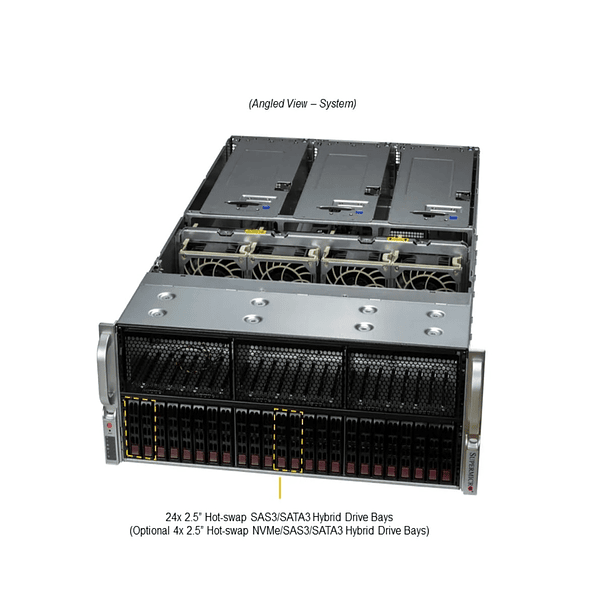Configure OSNexus QuantaStor on Supermicro servers
Description
Setting up a software-defined storage solution like OSNexus QuantaStor requires careful planning and a good understanding of both the underlying software and hardware.
Setting up OSNexus QuantaStor on Supermicro servers involves several steps, from hardware preparation to software configuration and best practices for optimal performance.
Here's a general guide:
1. Supermicro Hardware Preparation:
- Compatibility: Make sure your Supermicro servers are compatible with OSNexus QuantaStor. Supermicro often offers solutions pre-installed with QuantaStor, which greatly simplifies the process. Review the OSNexus Hardware Compatibility List (HCL). Supermicro servers based on X13/H13, X12/H12, X11, X10, and X9 with Intel and AMD EPYC/Scalable processors are generally supported.
- Network Connections (IPMI/BMC):
- Connect the 1GbE RJ45 IPMI/BMC port to your top-of-rack switch for out-of-band (OOB) management.
- Configure a static IP on the IPMI port to ensure continuous remote access.
- Familiarize yourself with the Supermicro IPMI interface (via IPMI View or the BMC Web GUI) to monitor your system, update firmware, and perform other management tasks.
- Power Supplies: If possible, connect dual server power supplies to separate PDUs for added redundancy.
- Discs:
- RAID Controllers: Please note that OSNexus QuantaStor is based on open storage technologies like Ceph and ZFS. This means that if you're using ZFS, using a hardware RAID controller is generally not recommended. Instead, OSNexus software will handle RAID.
- Data Pool Disks: Identifies the disks that will be used for the data pool.
- Metadata Pool Disks (SSD/NVMe): For configurations using HDDs as data devices, SSDs/NVMe are generally required for the metadata pool, as HDDs are too slow for storing file system metadata.
- Data Pool Offload Disks (SSD/NVMe): Consider using SSD/NVMe for write-ahead logging (WAL) and metadata offload (MDB) to improve read and write performance.
- RAM: The general recommendation is a 1:1 ratio, with 1 GB of RAM added for every TB of usable storage. For backup and archive setups, RAM requirements may be lower.
- Ethernet Ports: Configure Ethernet ports according to your network needs (10GbE, 25GbE, 40GbE, 100GbE, etc.).
- Processors: Select processors appropriate for your workload.
2. Installing OSNexus QuantaStor:
- If you purchased a Supermicro OSNexus solution, it likely comes pre-installed. Upon booting your system, you'll see the QuantaStor welcome screen and the console login page.
- If you need to install it, follow the instructions in the OSNexus QuantaStor installation guide.
3. Initial Configuration of OSNexus QuantaStor:
- Accessing the Console/Web GUI: Once the system boots, you will be able to access the QuantaStor console or web graphical user interface (GUI).
- Network Configuration:
- Configure the network interfaces with static IP addresses if necessary. For example, use the command qs np-modify --port=eno1 --ip-address=172.31.200.240 --netmask=255.255.0.0 --port-type=static --gateway=172.31.0.1.
- Check the configuration with qs np-list.
- License Activation:
- If you obtained a license key from Supermicro (SFT-OOB-LIC), activate it. This can be done in-band (from the localhost operating system) or out-of-band (via IPMI/BMC).
- In-band: Open a command prompt and run # sum -c ActivateProductKey --key <License_Key>.
- Out of band: Open a command prompt and run # sum -i <BMC_IP_address> -u <Username> -p <Password> -c ActivateProductKey --key <License_Key>.
- You can also activate it through the Supermicro Management Utility (SSM) web interface by uploading a text file with the BMC MAC addresses, BMC IP addresses, and license keys.
- Creating Storage Pools:
- Within the QuantaStor GUI, create storage pools using the identified disks for data and metadata.
- Define your storage layout and consider data compression if your workload allows.
- Service Configuration: Enable and configure the storage services you need (NFS, SMB/CIFS, iSCSI, Fibre Channel, S3).
4. Best Practices and Performance Considerations:
- Updates: Keep your operating system, Supermicro server firmware, and QuantaStor software up-to-date to ensure security and optimal performance.
- Redundancy:
- Implement a high availability (HA) solution if it is critical, using at least 2 or 3 servers per cluster.
- Connect power supplies to separate PDUs.
- RAM/Capacity Ratio: Follow the recommendation of 1 GB of RAM per TB of usable capacity for balanced performance.
- SSDs/NVMe for Metadata and Caching: Use dedicated SSDs/NVMe for metadata pools and performance offload (write-ahead-logging and metadata offload) on HDD-based systems to significantly improve performance.
- Monitoring: Uses OSNexus QuantaStor and Supermicro IPMI/BMC monitoring tools to monitor system status, performance, and events.
- Security: Implement security best practices, such as role-based access control (RBAC) and end-to-end encryption.
- Capacity Planning: Consider backfill space and reserved drive slots for future expansion and to avoid performance degradation.
Relevant Documentation:
- Supermicro-OSNEXUS Quick Start Guides: Supermicro often provides specific guides for its joint solutions with OSNEXUS.
- OSNexus QuantaStor Documentation: See the official OSNexus documentation for details on advanced configuration and troubleshooting.
- Supermicro IPMI View/BMC Manuals: For out-of-band management of your servers.
Setting up a software-defined storage solution like OSNexus QuantaStor requires careful planning and a good understanding of both the underlying software and hardware.

You might be interested in these


















